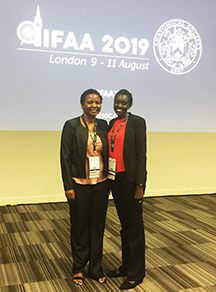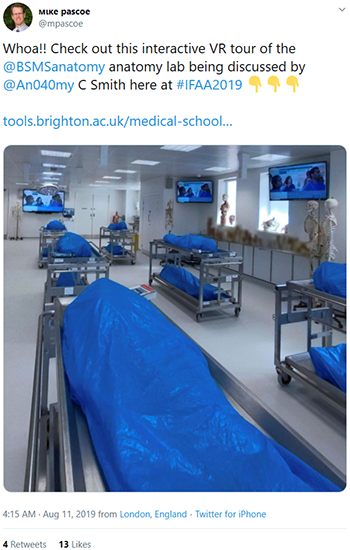IFAA Round-up
What did attendees, travel award winners, Twitter correspondents, and others experience at the 19th Congress of the International Federation of Associations of Anatomists? Find out in their own words (below) and see photos from staff and delegates in our Flickr album.

Habiba Chirchir
I received a travel award, for which I am very grateful, which gave me the opportunity to attend my first international anatomical conference. I met and interacted with anatomists from all over the world. I learned about different perspectives on anatomical education and ways to engage students in the classroom.
One of the highlights for me was a session on international mentorship, specifically, on how to recruit former students to give back their expertise and skillset to their alma mater. This makes use of the diverse knowledge that former students, who live and work in different parts of the globe, can offer. It’s something I have a keen interest in developing between my home institution in the USA and my home country of Kenya.
I gave a talk on the distribution of bone in the human lower limb from proximal to distal, which was co-authored by an undergraduate student. Our study found that there was no consistent reduction of bone density from proximal-distal as would be expected given that we walk long distances, contrary to some previous studies.
This was a great conference to attend; the programming was diverse, including topics on basic science research, education sessions, mentorship, use of technology in the classroom, and science outreach. The keynote speakers were outstanding and the topics they spoke on were highly instructive.
In the midst of all the anatomists from the various international organizations present, I enjoyed being an unofficial AAA representative at the IFAA. Last but not least, the medieval dinner was quite an entertainment!
Angelique Dueñas
I had the chance to present an oral presentation at IFAA, and being part of a session with so many international contributors was a wonderful experience. I learned so much about approaches to anatomy education in completely different settings than my norm. The whole conference overall had such informative sessions, and networking on an international scale felt new but was also really exciting. It was also great to have such an AAA presence there, and to know I could always have people to chat with, within my “home” society. Being able to meet peers from around the world in a fun and casual way (the student social) was such a great opportunity! Playing games and chatting, as well as learning about what other students study and their career goals, was much fun.
Michael Hortsch
“Brave New E-World! The Promises and Pitfalls of Digital Learning Resources for Teaching the Anatomical Sciences,” chaired by me, James Pickering, and Hannah Shaw, drew 100 highly-interested attendees. Our panel included presentations on various aspects of e-learning tools including access, implementation and effectiveness, budget implications, and inclusivity.
Laura Johnson
My participation would not have been possible without the generous support of the AAA Travel Award. The conference broadened my perspective on the shared, global nature of many of our educational activities in anatomy. I was able to sustain and create relationships with colleagues who are instrumental in my burgeoning research program on body donation programs, which has applicability in an international context. I am grateful to be part of the AAA and the many opportunities it provides members in research, education, and professional development.
Edgar Meyer
I was privileged to present a poster on “Visualization and measurement of the caudate nucleus of the brain from computed tomography angiography,” as well as a talk on “Stereoscopic learning and health sciences students’ retention of anatomy: does the “popping out” effect make a difference?

Mike Pascoe
I had the opportunity to share my research and educational experience in the workshop, “21st century anatomist: social media use in anatomy education and research.” Social media is increasingly used among anatomy educators to engage with learners and this session served as a forum for discussion on how to do so most effectively. I shared my experience integrating an anatomy themed Snapchat account (@AnatomySnap) into my summer Doctor of Physical Therapy anatomy courses at University of Colorado Anschutz.
Having found limitations with Twitter and Instagram, I saw great potential for success in Snapchat. 85% of my class followed the account and 87% percent viewed the content (“stories”) from beginning to end, yielding ~3,500 individual snap views. In a survey on usability, learners reported it was quite useful, felt confident in course material as a result, thought the content was extremely accurate, and were interested in having more course content presented through the account. I am currently processing the data on learning outcomes by comparing exam scores between the class that had access to the Snapchat account with the previous year’s class that did not.
For more on this session, readers can view the hashtag #AnatSoMe. A supplemental handout on Snapchat use is also available.
It was very enjoyable serving as a Twitter correspondent and I do encourage people to volunteer for future calls by the AAA. For me, it was exciting to view the congress through the lens of the anatomist who wasn’t in attendance, and try to provide content (text and multimedia) that would give the feel of being there. View #IFAA2019 through my eyes in this YouTube compilation of Snaps, which helped my students back in Colorado know exactly what I was doing at an international anatomy conference.
It was an overall phenomenal experience. I do a lot of professional networking on Twitter and it was great to meet many anatomists in person with whom I’ve been corresponding for many years. The congress was energizing in many ways. I learned a lot about improving my teaching and my educational scholarship, and a lot of anatomy as well. As a junior faculty member, I was able to appreciate the demonstration of what it’s like to be a renowned international expert in your area of scholarly work. Being immersed in such a diversity of anatomists also prompted me to reflect on how I represent my views and how to respect the views of others.
Mikaela Stiver
I am tremendously grateful to have received one of this year’s travel awards! Without AAA’s generous support, I would not have been able to attend the 19th IFAA Congress in London, UK. It was an honour to present a portion of my doctoral research to an international audience and to meet so many brilliant and inspiring anatomists from around the world.
Live-tweeting during a conference is always a fantastic experience! With such a jam-packed schedule and so many concurrent sessions during IFAA, Twitter was a valuable tool for getting the most out of the conference and facilitating on-going discussion. While not widely covered on Twitter, one of the highlights of the conference for me was the Friday night student social (co-sponsored by AAA and the Anatomical Society). It was the perfect opportunity for young anatomists to chat, enjoy good food and drinks, and play some fun games—anatomy-themed “Heads Up!” was a smash!
Kimberly Topp
I thoroughly enjoyed networking with colleagues from AAA, the Anatomical Society, and other associations across the globe. The plenary speakers were exceptional, and President Kramer’s call to support emerging anatomists was motivating! AAA was well represented throughout the conference!
Paul Trainor
In a session sponsored by Developmental Dynamics that focused on the embryology and anatomy of congenital birth defects and their potential for prevention and repair, I discussed the genetics and developmental biology underpinning rare craniofacial disorders such as Treacher Collins syndrome and Acrofacial Dysostosis-Cincinnati type, as well as more common conditions including cleft lip and palate. Other panelists discussed open neural tube birth defects such as spina bifida, as well as craniosynostosis, and the prospect for stem cell-based tissue bioengineering for improving surgical repair.
Annette Wu
Excerpted from Columbia University PathNews: [I] chaired the symposium session entitled “International Anatomy Workshop: Connecting Anatomists and Global Health,” designed to connect anatomists, scientists, and educators to the field of global health, and to inspire them to work on Global Health projects. The goal of the workshop was to give insight into the breadth of international work that anatomists can be involved in, provide skills and advice related to initiating and maintaining global health projects, and to launch new collaborations via a networking session.
Ann Zumwalt
I spoke in the very first session on the first morning on “Using Eye Tracking to Investigate Learning in the Anatomical Sciences.” It was an enjoyable experience, despite some technological issues that threw things a little off at first. Once that was resolved, I had fun giving the talk to what felt like a receptive and interested audience. I got some great questions and afterwards spoke with quite a few people who had great ideas, suggestions, or questions about my research. It was really cool to speak with people from other countries whom I would otherwise never meet.